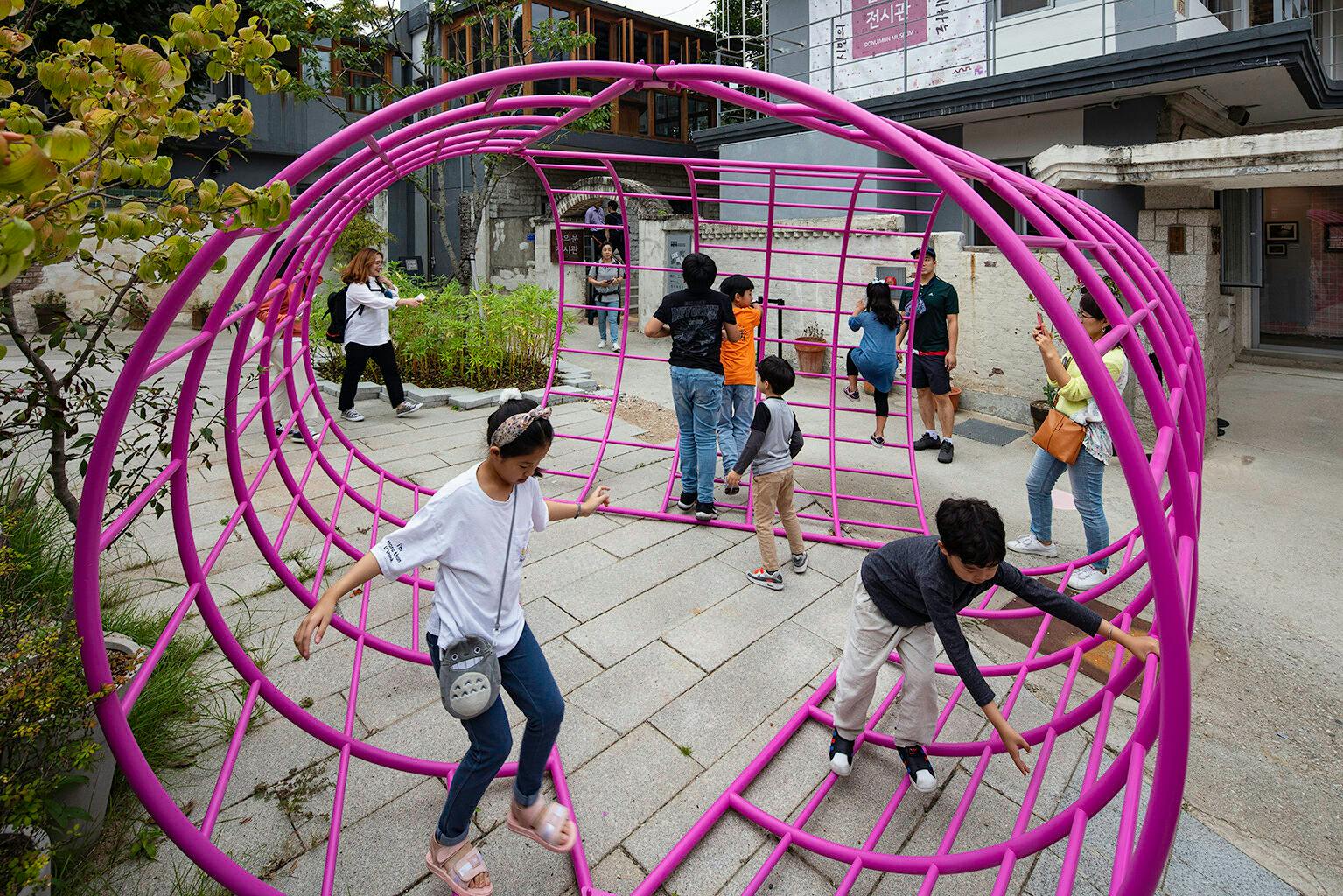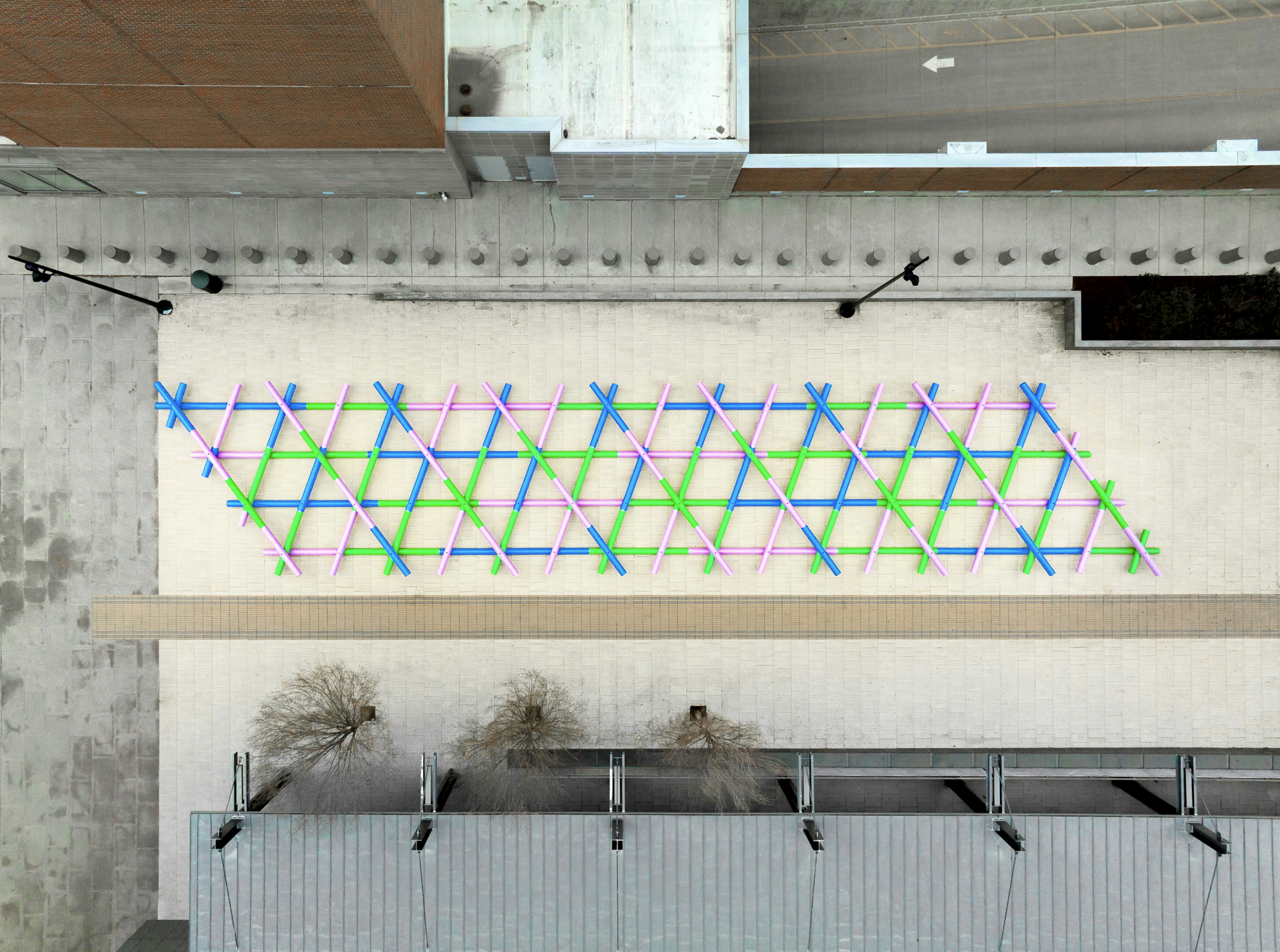Coryn Kempster + Julia Jamrozik on Pipelines in Downtown Denver







An interview with Toronto-based artists Coryn Kempster and Julia Jamrozik on the opening of Pipelines, a temporary, outdoor installation of over 100 PVC water and sewer pipes located in the newly renamed Plaza of the Americas in Downtown Denver.
Pipelines is presented by the Biennial of the Americas with artistic direction by Black Cube Nomadic Art Museum.
Coryn Kempster + Julia Jamrozik on Pipelines in Downtown Denver
Erica Cheung: I’d love to begin by speaking broadly about your shared practice, and what the main touchpoints in your work are. According to your artist statement, the two of you are committed to building “social infrastructure,” which is to say that you are invested in “creat[ing] spaces and objects that interrupt everyday situations in critically engaging and playful ways.” Can you unpack these ideas for us further?
Coryn Kempster + Julia Jamrozik: Social infrastructures for us are projects that bring elements of play and joy into the public realm. We see them as prompts that enable real-life connections to form—and as such we think that they are essential (as most other infrastructure is considered to be). We hope that they become catalysts for social interactions between friends and strangers.
EC: From what I understand, the two of you have been collaborating with each other since 2003—happy two decades of working together! You each wear many hats—as designers, artists, and educators—and I’m curious: Coryn, what perspective do you think Julia brings to your partnership? And Julia, what perspective do you think Coryn brings in return?
CK + JJ: We both studied art and design which gives us a common language and helps to bring clarity to the way we communicate with each other. Over the years we have developed a shorthand in some ways but we still try to resist making assumptions about what the other is thinking—we still surprise each other in the best way. We work in an iterative manner—always testing different ideas and critiquing them until something sticks for both of us.
CK: We fall easily into roles early on when we’re ideating—I’m very excitable and can get carried away easily while Julia is much more reflective and a fierce critic—she forces us to dig deeper and won’t let us rest until we’re both impressed with a concept before pushing it forward. She is also great at bringing her background in art history to bear on our practice—she is able to make connections between our own works and the work of others in insightful ways that help propel us forward, and happily, she is much better at writing than I am so she always takes the lead there.
JJ: Coryn is very passionate about the ideas as they form into projects and as they go through various stages in our studio. He becomes obsessive (in the best way possible) as he tackles each from different perspectives. He is resourceful, detail-oriented, and tireless in terms of pursuing a concept and making it into reality.
EC: Walk us through how these different—but clearly symbiotic—perspectives unfolded while iterating through ideas and plans for Pipelines.
CK + JJ: We had previously worked with irrigation pipes for a temporary installation in Medina, NY, in making a series of three-dimensional drawings with off-the-shelf materials. When we discovered that the EPA regional headquarters were immediately adjacent to the Denver site, we thought we could work with pipes there as a way of speaking about resource use, and more specifically water, especially given the ongoing drought in Colorado and Denver’s program to replace lead pipes in the city’s water supply. We were drawn to water and sewer pipes because of their ubiquitous road-side presence on construction sites and vibrant colors. We wanted to assemble the pipes in such a way that they could both talk about water infrastructure and be used as a social infrastructure in the public space. We also wanted to make a large scale, three-dimensional line drawing, a theme we keep returning to.
EC: One of the most notable elements of Pipelines is the installation’s monumental scale, given its use of large-scale PVC pipes used to move water and sewage. What is the significance of these materials, and how did they come to be the building blocks for Pipelines?
CK + JJ: We researched local manufacturers of water and sewer pipes and were grateful that James Johnson from JM Eagle’s nearby plant in Pueblo picked up the phone and was willing to not only speak with us and give great feedback on the pipes and our initial proposal for their arrangement, but also agreed to donate the pipes for the installation. It was also crucial to us that the pipes used in the installation would be recycled at the end, by shredding the material to turn into new pipe, and that was something they could accommodate. Once we had the support of JM Eagle we knew that we had the right material and this allowed us to further try different arrangements and configurations. JunoWorks took the lead in developing the connections that secure one pipe to another and in organizing the logistics of the installation.
EC: Other important qualities of Pipelines are that the installation is located in a highly trafficked place—the Plaza of the Americas in downtown Denver—and that it’s interactive, which is to say that viewers are invited to engage physically with the pipes. How do you envision audience participation contributing to the work and the site in which it’s positioned? How might this differ from installations shown in more conventional settings—i.e. a museum?
CK + JJ: We love seeing how members of the public interact with our work, and this has been particularly rewarding with Pipelines. Passersby have used it as a balance beam, a hangout spot, a parkour playground and a boxing ring, just to name a few. We think it is so important to create art in the public realm so that people from all walks of life have the opportunity to enjoy and interact with it, without going into an institutional space such as a museum. Some people may not even know that they are interacting with an artwork, and that is great!
EC: What were some of the biggest challenges or unexpected moments that arose while putting Pipelines together? What have you learned from this process?
CK + JJ: Time and money are usually the big challenges and it was no different with Pipelines. The installation was done in a relatively short timeframe and on a modest budget given the ambition of scale that the plaza demanded. We were lucky to collaborate with Black Cube, the project simply could not have happened without all their hard work, in-depth knowledge of the site and logistical constraints, but most importantly, their curatorial and project management support. Once we got JM Eagle on board and Black Cube brought JunoWorks to the table, the project came together very smoothly. What we learned on this project (as we do on most projects) is the value of great collaborators (and that it would always be great to have more time!).
